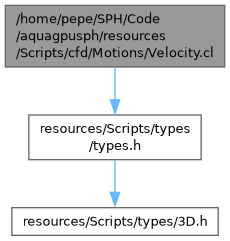Euler-XYZ based velocity computation. More...
#include "resources/Scripts/types/types.h"
Functions | |
| __kernel void | entry (const __global uint *iset, const __global int *imove, __global vec *r, __global vec *u, unsigned int N, unsigned int motion_iset, vec motion_r, vec motion_drdt, vec4 motion_a, vec4 motion_dadt) |
| Compute the boundary elements velocity applying Euler-XYZ motion. | |
Detailed Description
Euler-XYZ based velocity computation.
Function Documentation
◆ entry()
| __kernel void entry | ( | const __global uint * | iset, |
| const __global int * | imove, | ||
| __global vec * | r, | ||
| __global vec * | u, | ||
| unsigned int | N, | ||
| unsigned int | motion_iset, | ||
| vec | motion_r, | ||
| vec | motion_drdt, | ||
| vec4 | motion_a, | ||
| vec4 | motion_dadt | ||
| ) |
Compute the boundary elements velocity applying Euler-XYZ motion.
In Euler-XYZ the following transformation is applied to a particle \( a \):
\[ R_z \cdot R_y \cdot R_x \cdot \mathbf{x_a} + \mathbf{cor}, \]
where \( \mathbf{cor} \) is the position of the center of rotation (global translations), and \( \mathbf{x_a} \) is the constant position of the boundary element with respect to \( \mathbf{cor} \), and \( R_x, R_y, R_z \) are the rotation matrices:
\[ R_x = \left[ \begin{matrix} 1 & 0 & 0 \\ 0 & \mathrm{cos}(\phi) & -\mathrm{sin}(\phi) \\ 0 & \mathrm{sin}(\phi) & \mathrm{cos}(\phi) \\ \end{matrix} \right], \]
\[ R_y = \left[ \begin{matrix} \mathrm{cos}(\theta) & 0 & \mathrm{sin}(\theta) \\ 0 & 1 & 0 \\ -\mathrm{sin}(\theta) & 0 & \mathrm{cos}(\theta) \\ \end{matrix} \right], \]
\[ R_z = \left[ \begin{matrix} \mathrm{cos}(\psi) & -\mathrm{sin}(\psi) & 0 \\ \mathrm{sin}(\psi) & \mathrm{cos}(\psi) & 0 \\ 0 & 0 & 1 \\ \end{matrix} \right]. \]
To compute the velocity the following process can be followed:
- The velocity due to the rotations is computed in the local coordinates: \( \omega \times \mathbf{x_a} \), with \( \omega = \left[ \dot \phi, \dot \theta, \dot \psi \rigth] \)
- Then the vector is rotated using the rotation matrix.
- Finally the linear velocity, \( \dot \mathbf{cor} \) is added.
- Parameters
-
iset Set of particles index. imove Moving flags. - imove > 0 for regular fluid particles.
- imove = 0 for sensors.
- imove < 0 for boundary elements/particles.
r Position \( \mathbf{r} \). u Velocity \( \mathbf{u} \). N Number of particles. motion_iset Set of particles affected. motion_r Center of rotation. motion_drdt Center of rotation velocity. motion_a Rotation angles \( \phi, \theta, \psi \). motion_dadt Angular velocities.
- See also
- MotionTransform.cl